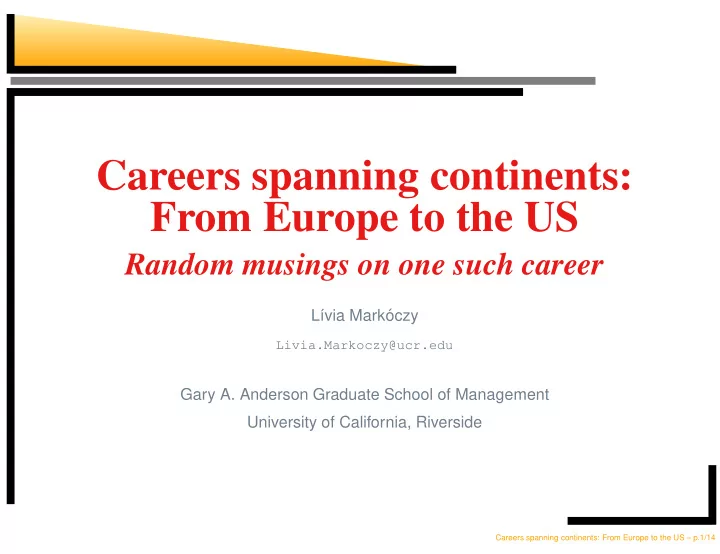

Careers spanning continents: From Europe to the US Random musings on one such career ıvia Mark´ L´ oczy Livia.Markoczy@ucr.edu Gary A. Anderson Graduate School of Management University of California, Riverside Careers spanning continents: From Europe to the US – p.1/14
My background (in one slide) Undergraduate degree and “doktori” degree in Business Economics from the Budapest University of Economic Sciences. (Then Karl Marx University of Economics). taught Business Economics there for 2 years. Ph.D in Management from the University of Cambridge, UK. Worked at Cranfield University UK for 5.5 years. Currently I am an Assistant Professor of Management at the University of California, Riverside. Careers spanning continents: From Europe to the US – p.2/14
British PhD training Intended not only for academics, but for consultants and practicing managers as well (eg, a “super-MBA”). One or two required course. The rest is “directed research” Student is a student of a particular supervisor, not of a department. Careers spanning continents: From Europe to the US – p.3/14
US PhD training Intended for those pursuing academic careers only. While not all follow such careers, that is the intent on starting. More than two years of full course work, covering all core areas of management research, as well as advanced seminars. While the supervisor matters a great deal, the whole department takes an interest in each student. Careers spanning continents: From Europe to the US – p.4/14
British Methodology Students work on their research topics from the very beginning of their studies. Single “methodology” is more philosophy of science than training in methods. Student typically only learns the method needed for their PhD. No formal training in theory, beyond the reading directed by the supervisor. Careers spanning continents: From Europe to the US – p.5/14
US Methods Training in lots of technical methods, with foundation of those methods. Expectation that choice of method will follow each particular research question. Training in various theories in all major areas of the field (whether part of student’s area of focus or not). Careers spanning continents: From Europe to the US – p.6/14
The mediocre British junior paper Seemingly grand theory about life, the universe and everything (but not really all that innovated when looked at closely) References to obscure and varied bits of the literature, but often missing mainstream stuff. Discussions of philosophy of science. No search for nor attempt to rule out alternative explanations. Careers spanning continents: From Europe to the US – p.7/14
The mediocre US junior paper Is a variant of some existing paper, but with a trivial change to one variable (already known to be related to the one used in the original paper). Cites noting except what has been published in the management literature within the previous five years. Will follow some method formulaicly, rarely thinking whether it can be improved upon. Arguments for choice of method rely only on precedent instead of on merit of the method itself. Careers spanning continents: From Europe to the US – p.8/14 Only explicitly considers (and tries to rule out)
So what’s a European trained student 1. Develop an overall understanding of the current state of the field. Read top journals cover to cover (not just in your area). 2. Get comfortable with principles and practice of statistics, so you can pick up analysis techniques as needed. 3. Explicitly search for alternatives explanations of phenomena you seek to explain. 4. Make sure your PhD research is such that you will be able to publish from it. Many junior faculty milk their theses for years. Careers spanning continents: From Europe to the US – p.9/14
So what’s a US trained student to do? Other’s can answer this question better than I. 1. Select research topics with the practical importance in mind 2. Collect data directly from companies as opposed to use archival data or experiments 3. Read outside the field in areas involving social thought. This may do not help your research but will make you more popular when socializing with your colleagues in pubs ;-) Careers spanning continents: From Europe to the US – p.10/14
Pressure on European junior faculty Your first job will be as a PhD student where you study and will typically continue there. Typically work for group leader/supervisor on their funded project; often a consulting project. You often expected to produce publications from projects that originally started as a consulting work which is very hard to do. Careers spanning continents: From Europe to the US – p.11/14
Pressure on US junior faculty First job is highly competitive. Research record and potential are the main selection criteria. Paid and supported to do own research. Tenure pressure to publish so great that research projects become exceedingly conservative. Careers spanning continents: From Europe to the US – p.12/14
Final musings Although I prefer the US system, I regret the pressure to be conservative, and miss the “just talking about ideas” of my youth. There are many exceptions to my broad brush characterizations. Experience in both systems makes me more appreciative of each strengths. Careers spanning continents: From Europe to the US – p.13/14
Resources A version of these slides is available www.goldmark.org/livia/papers/int-career/ Careers spanning continents: From Europe to the US – p.14/14
Recommend
More recommend